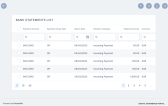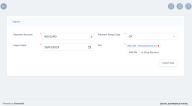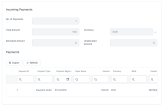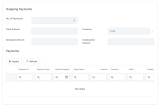Import Bank Statements
The Bank Statements feature helps you manually add payment data into the system. Uploading a bank statement file triggers the automatic parsing, sorting, and matching of the Incoming Payments data contained by the file, with the Invoices already registered into the system. For payments that respect some rules, such as providing the correct unique identifier for an installment or the number of the policy, the allocation flow is completely automated.
After import, you can find all the new payments into the general list, from the Payments section. You can recognize the automatically allocated payments by their Closed business status. More details about how the system does the sorting of the received payment data, in the Incoming Payments technical documentation.
You can register Outgoing Payments in the system, namely, those requests for payments that your bank sends with the bank statement file. More details about how the system does the sorting of the received payment requests data, in the Outgoing Payments technical documentation. For some of your recurring outgoing payments scenarios, like paying the electricity bill, you can configure Billing & Collection to automatically approve and allocate those types of outgoing payments. For more details about managing Outgoing Payments with the Billing & Collection solution, consult the Outgoing Payment Requests page.
You can only delete Bank Statements that contain Unallocated payments.
There are cases when you need to upload your bank statement files manually. To import payments, you need to use the standard bank statement file issued by your bank, for your bank accounts. For example, some banks use the MT940 format file for issuing statements. Also, you use this same functionality to import standardized files from other payment processors - such as PayU. The Billing & Collection solution can parse through different standardized payment data files.
Follow the below steps to add payment data into your system:
-
Go to Main Menu > Billing & Collection > Bank Statements. The Bank Statements grid is displayed, containing the list of all statements records.
-
Click Insert. The Import page is displayed, where you can input the details for the payment.
-
Input the payment details, and add the bank statement file. You need to fill in the following fields:
-
Payment Account: From the dropdown, select the bank account standardized file type and click Ok. The current option set values are: BRD MT940 EUR, BRD MT940 RON, ING EURO, and ING RON;
-
Payment Group Type: From the option set, select the group type for processing payments. You can choose between OP (bank payment) or PayU (for online payment processors);
-
Import Date: You can either Add or Drop the file containing the payment data.
-
-
Click Import Data.The payment data view appears, and the record is in the Imported status.
-
View the record details. The following two tabs are available:
-
The Bank Statement, automatically populated with details, either introduced in the previous step or extracted from the file, such as the IBAN.
-
The Payments tab, displaying the payments from the imported file. The following sections are available in this tab:
-
The Incoming Payments section, automatically populated with details extracted from the imported file. At the bottom of the section, you can see the Payments grid, containing every incoming payment extracted from the imported file.
Next to each unallocated incoming payment there is a Payment Return button. For details about returning unallocated payments, consult the Returning Payments section of this guide.
-
The Outoing Payments tab, automatically populated with details extracted from the imported file. Similarly to the previous section, at the bottom of the section, you can see the Payments grid, containing every outgoing payment extracted from the imported file. In case there are many outgoing payments, you can use the search functionality in this grid, to find a certain outgoing payment.
Next to each unallocated incoming payment there is a Payment Return button. For details about returning unallocated payments, consult the Outgoing Payment Requests section of this guide.
-
-




